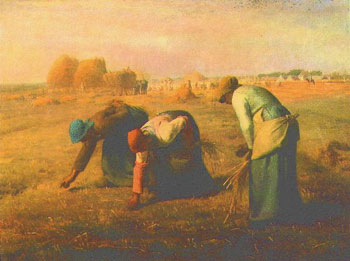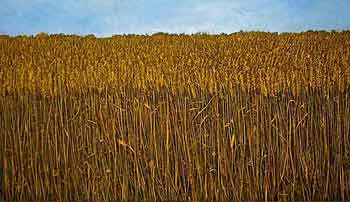|










|
|
- "Jesus was going
through the wheat fields"
Mark 2, 23
-
- After July, the harvest season is starting in Europe.
Innumerable vacationers, either not paying attention or amazed,
go through the wheat fields.
-
 |
-
- What do they know of the farmer who has worked the land,
threw in the seed, looked upon his crop all through winter, struggled
against the weeds, worried sick during the storms threatening
the maturing heads of wheat? Jesus, inhabitant of the Nazareth
village, likely would have had full attention and tenderness
when he was going through these fields with his disciples, for
him these fruits of the land were singing praise to the Creator.

|
Is not wheat a symbol of human life? |
Symbol of prenatal life: between sowing and harvest there are
nine months, the time of a gestation.
Symbol of life from birth to the grave: with these long periods
of deep rooting, of stagnation, apparently useless before the
sudden appearance of the grains. It is also the time of fight
against the weeds: our lives, facing the evil, revealed themselves
full of tensions and ambiguities before the coming of wisdom
ready to be harvested.
Symbol of life after death: this reality that Jesus speaks about
when he calls to mind " the seed that die" to
bring fruit. Can this be imagined? St. Paul admits he is incompetent:
"How are the dead raised?…what you sow is not the
body which is to be, but a bare kernel, of wheat for example…and
God gives it a body as he has chosen…it is sown in weakness,
it is raised in power; it is sown a physical body, it is raised
a spiritual body " 1 Co, 15, 35-44).
The wheat in the parables plays a front role in the announcement
of the Kingdom:
-

|
"the farmer has gone out to sow…" |
-
- The grain generously falls on all kind of soil. Though
Jesus showed his interest for the good soil where the seed can
produce thirty, sixty or one hundred fold, he did not seem attracted
by the result, it is not his first concern. He abundantly sowed
the words, to a point that Mark made the remark: "All
day long Jesus had spoken in parables" (Mark, 4, 35).
To make himself understood, he used the agricultural experience
of his listeners: " Don't you say: there are still four
months to go for the harvest?" Four months is a long
time compare with the nine months of growing of the wheat, four
months before is the period when the wheat has not yet produce
the grains, apparently you could confuse it with a weed. "Four
months before" is then the symbol of the faith in the success
to come, the expectation that a process of evolution is working
and it will come to its final term.
And when harvest time has come, Jesus invites us to contemplation:
"Lift up your eyes, and see how the fields are white
for harvest" (John, 4, 35). He envisage in the same
glance the time for sowing and the one for harvest;" He
who reaps receives wages; he gathers fruit for eternal life so
that sower and reaper may rejoice together"(John 4,
36). It is especially true for him, the Son of God.

|
Regarding the Apostles, Jesus underlying the primary mission
of being sowers, without worrying about collecting the fruits
of their labors: |
-
- "One sows and another reaps: I sent you to reap
that for which you did not labor; others have labored, and you
have entered into the fruit of their labor." (John 4,
38).
With all his disciples dispersed all over the planet, Christ
continues his undertaking and goes through the wheat fields of
the world.
|
